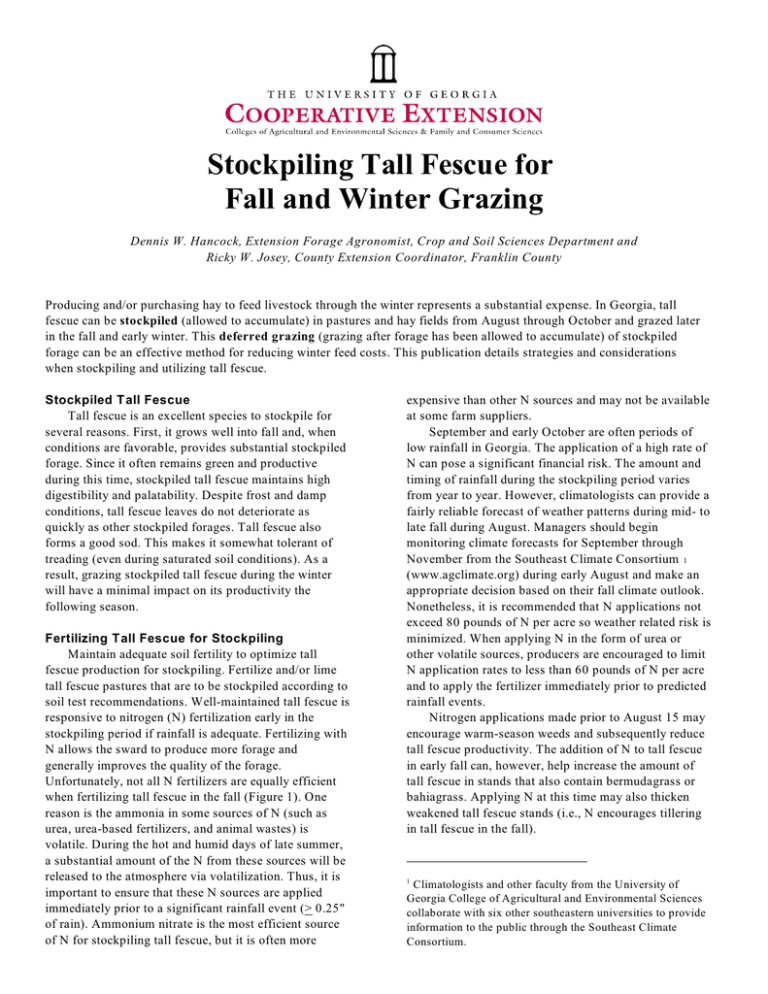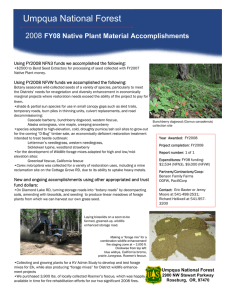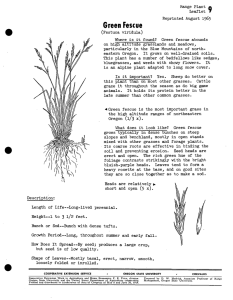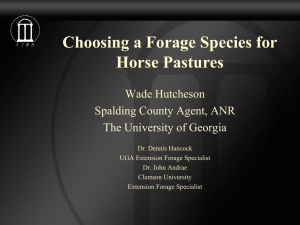Stockpiling Tall Fescue for Fall and Winter Grazing
advertisement

Stockpiling Tall Fescue for Fall and Winter Grazing Dennis W. Hancock, Extension Forage Agronomist, Crop and Soil Sciences Department and Ricky W. Josey, County Extension Coordinator, Franklin County Producing and/or purchasing hay to feed livestock through the winter represents a substantial expense. In Georgia, tall fescue can be stockpiled (allowed to accumulate) in pastures and hay fields from August through October and grazed later in the fall and early winter. This deferred grazing (grazing after forage has been allowed to accumulate) of stockpiled forage can be an effective method for reducing winter feed costs. This publication details strategies and considerations when stockpiling and utilizing tall fescue. Stockpiled Tall Fescue Tall fescue is an excellent species to stockpile for several reasons. First, it grows well into fall and, when conditions are favorable, provides substantial stockpiled forage. Since it often remains green and productive during this time, stockpiled tall fescue maintains high digestibility and palatability. Despite frost and damp conditions, tall fescue leaves do not deteriorate as quickly as other stockpiled forages. Tall fescue also forms a good sod. This makes it somewhat tolerant of treading (even during saturated soil conditions). As a result, grazing stockpiled tall fescue during the winter will have a minimal impact on its productivity the following season. Fertilizing Tall Fescue for Stockpiling Maintain adequate soil fertility to optimize tall fescue production for stockpiling. Fertilize and/or lime tall fescue pastures that are to be stockpiled according to soil test recommendations. Well-maintained tall fescue is responsive to nitrogen (N) fertilization early in the stockpiling period if rainfall is adequate. Fertilizing with N allows the sward to produce more forage and generally improves the quality of the forage. Unfortunately, not all N fertilizers are equally efficient when fertilizing tall fescue in the fall (Figure 1). One reason is the ammonia in some sources of N (such as urea, urea-based fertilizers, and animal wastes) is volatile. During the hot and humid days of late summer, a substantial amount of the N from these sources will be released to the atmosphere via volatilization. Thus, it is important to ensure that these N sources are applied immediately prior to a significant rainfall event (> 0.25" of rain). Ammonium nitrate is the most efficient source of N for stockpiling tall fescue, but it is often more expensive than other N sources and may not be available at some farm suppliers. September and early October are often periods of low rainfall in Georgia. The application of a high rate of N can pose a significant financial risk. The amount and timing of rainfall during the stockpiling period varies from year to year. However, climatologists can provide a fairly reliable forecast of weather patterns during mid- to late fall during August. Managers should begin monitoring climate forecasts for September through November from the Southeast Climate Consortium 1 (www.agclimate.org) during early August and make an appropriate decision based on their fall climate outlook. Nonetheless, it is recommended that N applications not exceed 80 pounds of N per acre so weather related risk is minimized. When applying N in the form of urea or other volatile sources, producers are encouraged to limit N application rates to less than 60 pounds of N per acre and to apply the fertilizer immediately prior to predicted rainfall events. Nitrogen applications made prior to August 15 may encourage warm-season weeds and subsequently reduce tall fescue productivity. The addition of N to tall fescue in early fall can, however, help increase the amount of tall fescue in stands that also contain bermudagrass or bahiagrass. Applying N at this time may also thicken weakened tall fescue stands (i.e., N encourages tillering in tall fescue in the fall). 1 Climatologists and other faculty from the University of Georgia College of Agricultural and Environmental Sciences collaborate with six other southeastern universities to provide information to the public through the Southeast Climate Consortium. Novel-endophyte (NE) infected tall fescue (e.g., MaxQ) does not produce the problematic toxins and can provide excellent animal performance when stockpiled in the fall. For example, stocker cattle performance on stockpiled NE tall fescue is shown quite satisfactory (Table 1). However, this study showed stocker cattle gains were substantially reduced when provided stockpiled E+ tall fescue. As a result, NE tall fescue is the only stockpiled tall fescue recommended for stocker cattle, finishing cattle, dairy cows, and replacement heifers. In contrast, research has shown there is no significant difference in the productivity of calves nursing fall-calving cows grazing endophyte free (E-) or E+ stockpiled tall fescue (Curtis and Kallenbach, 2007). Though research indicates that dry or lactating brood animals may lose body condition while grazing stockpiled E+ tall fescue, similar losses in body condition during this period is also common when the animals are fed bermudagrass or E+ tall fescue hay. Thus, stockpiled tall fescue (regardless of endophyte type) is a recommended strategy for carrying brood animals through late fall and early winter. Stockpiled tall fescue can also be an effective strategy to reduce the expense of carrying horses through winter. However, pregnant mares in the last 60-90 days of gestation should not be fed E+ tall fescue. The decline in the concentration of the toxins during the fall and winter may not sufficiently reduce the risks of prolonged gestation, dystocia (foaling difficulty), thickened placenta, or agalactia (decrease in milk production) associated with E+ tall fescue. NE tall fescue does not pose these problems and could be used for horse grazing during this period. Figure 1. Yield response of tall fescue in late summer to an increasing rate of various N sources, averaged over 3 years. Adapted from Teutsch et al., 2005. Forage and Grazinglands. Online. doi:10.1094/FG-2005-1220-01-RS. The Endophyte and Stockpiled Tall Fescue Tall fescue is the primary forage species in many pastures in north Georgia. Unfortunately, most of the tall fescue pastures are infected with a toxin-producing endophyte (a fungus that grows within the plant). The toxins are ergot-alkaloids that adversely affect livestock in decreased weight gain, decreased milk production, constricted blood flow (especially to extremities), and decreased reproductive efficiency. These problems are collectively referred to as “fescue toxicosis.” Stockpiled forage from endophyte-infected (E+) tall fescue will contain these toxins, especially when the fescue has been provided high levels of N fertilization during stockpiling. Though the concentration of these toxins will decrease during late fall and through the winter, animal performance may suffer. Table 1. The effects of endophyte status in fall stockpiled tall fescue pastures on average daily gains (ADG) and gains per acre of stocker cattle at Calhoun and Eatonton, Ga. during 1999 to 2002: 3-year averages (Adapted from Parish et al., 2003). Calhoun Eatonton ADG (lbs/day) Gain (lbs/acre) ADG (lbs/day) Gain (lbs/acre) NE 1.81** 500 1.79 395 E- 1.85 498 1.92 428 E+ 0.90 364 1.23 278 Tall Fescue* * ** NE = Novel-endophyte infected tall fescue; E- = Endophyte-free tall fescue; E+ = Tall fescue infected with the wild-type endophyte. W ithin a column, values in bold are not significantly different (P<0.05) from the highest value. 2 Expectations After many years of experiments in Georgia and other states in the southeastern United States, researchers have determined that stockpiling tall fescue is a costeffective strategy to provide winter forage needs. It is difficult to give a “rule-of-thumb” as to number of grazing days that can be expected from an acre of stockpiled tall fescue. Year-to-year variability in weather means an “average” number of grazing days may not indicate the true number of grazing days in any given year. Managers should consider best-case, worst-case, and average scenarios. Furthermore, differences in the efficiencies of various grazing management systems need to be considered. The common practice of allowing animals to have continuous access to very large pastures (continuous stocking) is an inefficient grazing system. Studies have shown only 30-40 percent of the forage produced will be consumed by the animal when pastures are continuously stocked. Rotating animals between four or more subdivided areas, or paddocks, within a pasture (rotational stocking) can improve forage use efficiency to 50-60 percent. Rationing out small strips of pasture (strip grazing) every 1-3 days can improve grazing efficiency to a point where 65-75 percent of the forage produced will be consumed. By using an estimate of the amount of stockpiled forage available and considering the relative efficiency of the grazing system, a producer can use the following calculation to estimate the number of days an acre of stockpiled tall fescue can carry an individual animal: (Total Available Forage x Grazing Efficiency) Grazing Days = (Average Body W t. x Daily Dry Matter Intake, % of b.w.) Acre 33 Days Example: (2,000 lbs/acre x 40%) = Acre (1,200 lbs/cow x 2% /day) This equation was used to generate the data in Table 2. It provides a more detailed look at the approximate grazing days for dry beef cows given different levels of available forage and grazing intensity. In practice, the manager should adjust the number of grazing days to the amount of stockpiled forage available. Obtaining an accurate measurement of available forage can be difficult. Grazing management tools, such as a grazing stick, rising plate meter, or other commercially-available devices, can provide a reasonable estimate of available forage. Table 2. Approximate number of days one cow (1,200 lbs.) can graze an acre of stockpiled tall fescue containing 1,500, 2,000, and 2,500 dry lbs./acre of available forage when using continuous stocking, moderate rotational stocking, or strip grazing management. Available Forage Continuous Stocking (dry lbs/acre) Moderate Rotational Stocking Strip Grazing ------------------------------(cows-days/acre)------------------------------ 1500 19-25 31-38 41-47 2000 25-33 42-50 54-63 2500 31-42 52-63 68-78 Assumptions: 1200 lb dry cow; intake of stockpiled forage = 2.0% of body weight; grazing efficiency: 30-40% for continuous stocking; 50-60% for moderate rotational stocking (5-6 paddocks); and 65-75% for strip grazing (the allowance of strips that are rationed to the animals based on need and forage availability). Timeline and Recommended Procedures for Stockpiling Tall Fescue in Georgia Early- to mid-September – Sept. 1-15: Mountain/Limestone Valley and Sept. 15-30: Piedmont 1. Closely graze or clip (to a stubble height of 2") the tall fescue pasture or hayfield that is to be stockpiled. 2. Remove livestock from the area and allow them to graze warm season perennial (bermudagrass, bahiagrass) or summer annual (pearl millet, sorghum-sudan, etc.) pastures. 3. 3 Apply 60-80 pounds of N per acre (ammonium nitrate is recommended). Preferably, apply the fertilizer immediately prior to predicted rainfall events. a. If a volatile source of N (e.g., urea-based, animal waste) is to be used or fall rainfall is predicted to be below average, consider limiting N application rates to less than 60 pounds of N per acre. Late October through November – Oct. 15-Nov. 20: Mountain/Limestone Valley and Nov. 1-30: Piedmont 1. Measure the amount of stockpiled forage available (i.e., clip and weigh, rising plate meter, or grazing stick). 2. Obtain a clipped sample for forage quality analysis. 3. Allow livestock to strip graze the stockpiled tall fescue to make the most efficient use of the available forage. 4. Supplement with grain or by-products based on a ration balanced to the quality of the available forage and the needs of the animal class (Note: brood animals will likely need little or no supplementation). 5. Obtain additional clipped samples from the stockpiled forage as needed for forage quality analysis so that supplementation can be altered and animal productivity maintained. References Curtis, L.E., and R.L. Kallenbach. 2007. Endophyte infection level of tall fescue stockpiled for winter grazing does not alter the gain of calves nursing lactating beef cows. J. Anim Sci. 85:2346-2353. Summary When there is adequate rainfall in the fall, removing animals from tall fescue pastures or hayfields and fertilizing the tall fescue with 60-80 pounds of N/acre will allow forage growth to stockpile for late fall and winter grazing. Utilization of stockpiled tall fescue and, in particular, tall fescue infected with the novelendophyte (e.g., MaxQ) is an economicallyadvantageous management strategy because it extends the grazing season, minimizes winter hay feeding, substantially reduces stored feed requirements, provides high-quality forage, and does not negatively impact the persistence of tall fescue stands. This is a strategy that is highly recommended to producers who utilize fescue in their forage system. Related Publications Novel Endophyte-Infected Tall Fescue, University of Georgia Extension Service Circular 861 Parish, J.A., M.A. McCann, R.H. Watson, N.N. Paiva, C.S. Hoveland, A.H. Parks, B.L. Upchurch, N.S. Hill, and J.H. Bouton. 2003. Use of nonergot alkaloid-producing endophytes for alleviating tall fescue toxicosis in stocker cattle. J. Anim. Sci. 81:2856–2868. Teutsch, C.D., J.H. Fike, G.E. Groover, and S. Aref, 2005. Nitrogen rate and source effects on the yield and nutritive value of tall fescue stockpiled for winter grazing. Online. Forage and Grazinglands doi:10.1094/FG-2005-1220-01-RS. The University of Georgia and Ft. Valley State University, the U.S. Department of Agriculture and counties of the state cooperating. Cooperative Extension, the University of Georgia College of Agricultural and Environmental Sciences, offers educational programs, assistance and materials to all people without regard to race, color, national origin, age, gender or disability. An Equal Opportunity Employer/Affirm ative Action Organization Comm itted to a Diverse W ork Force C920 January 2008 Issued in furtherance of Cooperative Extension work, Acts of May 8 and June 30, 1914, The University of Georgia College of Agricultural and Environmental Sciences and the U.S. Department of Agriculture cooperating. J. Scott Angle, Dean and Director





